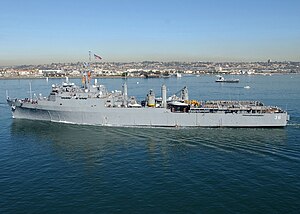Anchorage class dock landing ship

USS Anchorage (LSD-36)
|
|
| Class overview | |
|---|---|
| Operators: | |
| Preceded by: | Thomaston-class dock landing ship |
| Succeeded by: | Whidbey Island-class dock landing ship |
| Built: | 1967–1972 |
| In commission: | 1969–2003 |
| Completed: | 5 |
| General characteristics | |
| Type: | Dock landing ship |
| Displacement: | 14,000 long tons (14,225 t) Full |
| Length: | 553 ft (169 m) |
| Beam: | 85 ft (26 m) |
| Draft: | 20 ft (6.1 m) |
| Propulsion: |
|
| Speed: | 22 knots (25 mph; 41 km/h) |
| Range: | 14,800 nmi (27,400 km; 17,000 mi) at 12 kn (22 km/h) |
| Boats & landing craft carried: |
LCACs |
| Complement: | 18 officers, 340 enlisted |
| Armament: |
|
The Anchorage-class dock landing ships were a series of five dock landing ships (LSD) constructed and commissioned by the United States Navy between 1965 and 1972. US Navy decommissioned all five of them by 2003. They are succeeded by Whidbey Island-class LSDs and Harpers Ferry-class LSDs.
The Anchorage class of dock landing ships was built as a replacement for the remaining aging war-built LSDs of the Ashland and Casa Grande classes. Their principal intended role was to carry additional landing craft to supplement those carried by the Amphibious transport docks (LPD)s, which carried less landing craft in order to accommodate more troops and cargo.
The Anchorage class was slightly larger than the preceding Thomaston class, but were of generally similar design, with a large Well dock aft to accommodate landing craft, and a removable flight deck fitted above the well deck to allow the operation of helicopters, although no hangar was provided. The well dock was 430 feet (130 m) long and 40 feet (12 m) wide, and could accommodate three Landing Craft Utilitys or nine LCM-8 Landing Craft Mechanised. The ship could carry 375 troops compared with the 345 carried by the Thomastons, while 12,000 square feet (1,115 m2) of vehicle parking space was provided.
The ships were propelled by two geared steam turbines driving two shafts and giving a total of 24,000 shaft horsepower (18,000 kW). This gave a speed of 20 knots (23 mph; 37 km/h), the standard speed of the postwar US Navy amphibious fleet. As built, the ships had a defensive armament of eight 3"/50 Mark 33 anti-aircraft guns in four twin mounts, while major sensors included SPS-10 surface search radar and SPS-40 air-search radar.
...
Wikipedia
